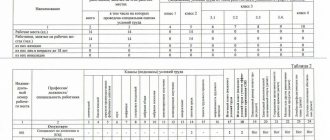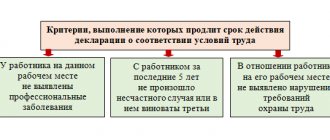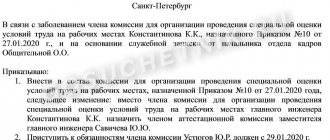What is the program for?
The head of an enterprise or organization is obliged to create an optimal and safe working environment (Article 163 of the Labor Code of the Russian Federation).
The occupational safety and health action plan for 2021 is a mandatory regulatory document for any organization if the costs of occupational safety and health are significant and there is an intention to reimburse them to the Social Insurance Fund. Having the document will allow you to reduce insurance premiums for occupational injuries in the Social Insurance Fund. A reduction is possible by the amount of funding for measures to improve conditions and reduce accidents at work. Every year, before August 1, a company can submit an application to the Social Insurance Fund in any form. The procedure for reimbursement of costs for improving working conditions is regulated by the Rules for financial support of preventive measures to reduce industrial injuries and occupational diseases of workers and sanatorium and resort treatment of workers engaged in work with harmful or dangerous production factors (annex to the Order of the Ministry of Labor and Social Protection of the Russian Federation dated December 10, 2012 No. 580n). The program for improving working conditions for the current year will be the main document for the return of contributions for injuries for the previous year. You can return up to 20% of the funds actually transferred. The list of additional documents is determined by the same Order depending on the activities for which the costs will be reimbursed.
Reimbursement
The costs of some occupational safety measures can be offset by contributions to compulsory social insurance against accidents at work and occupational diseases. The rules of compensation are regulated by Order of the Ministry of Labor of the Russian Federation dated December 10, 2012 No. 580n. The full list of expenses subject to compensation is specified in clause 3 of the Order.
How much should I allocate?
Up to 20% of the amounts of insurance premiums that were accrued over the past year are allocated for compensation of costs. This does not include the cost of paying benefits for temporary disability (cause: accidents during the work process, occupational diseases) and paying for additional leave for medical procedures.
Compensation can increase up to 30% if the employer allocates additional funds for the treatment of employees in sanatorium-resort institutions. These funds must be transferred no earlier than five years before employees reach the age of appointment of an old-age insurance pension.
Required documents and deadlines for their submission
All documentation is submitted to the FSS office at the place of registration before August 1 of the current year.
You will need:
- statement of financial support for preventive measures in paper or electronic form;
- plan for financial support of preventive measures for the year. It is developed taking into account a list of measures to improve the working conditions and safety of workers and (or) another document with the specified amount of funding;
- a copy of the action plan to improve working conditions and safety;
- documents justifying the need to finance preventive measures depending on the activities included in the financial support plan (clause 4 of the Order).
What legal acts establish the requirements?
The development of a plan for improving working conditions is regulated by the following laws and regulations:
- Labor Code of the Russian Federation, Federal Law No. 197-FZ of December 30, 2001 (Articles 212, 226).
- System of occupational safety standards. Occupational safety management systems - GOST 12.0.230.1-2015 (describes the occupational safety management system, planning and prevention).
- A typical list of measures annually implemented by the employer to improve working conditions and safety and reduce occupational risks, approved. Order of the Ministry of Health and Social Development of the Russian Federation dated March 1, 2012 No. 181n (contains a list of activities that can be included in the plan to improve working conditions).
In Art. 226 of the Labor Code of the Russian Federation states that a manufacturing enterprise must spend at least 0.2% of production costs on improving working conditions and labor protection. The list of activities was approved by Order of the Ministry of Health and Social Development of the Russian Federation No. 181n dated March 1, 2012. The local annual plan of events determines what the funds will be spent on. This planning document is formed annually (or once every two to three years). The procedure for its development and approval is included in the labor protection regulations.
Good and safe conditions are ensured by:
- rational distribution of the load between the employee and the equipment;
- using reasonable standards of work and rest;
- improvement of technological processes and equipment;
- selection of professional personnel.
What should the plan contain?
When drawing up a plan, you should focus on Order of the Ministry of Health and Social Development of Russia dated March 1, 2012 No. 181n. The list of measures to improve working conditions and increase safety contains 32 items. You need to select events that are relevant to a specific organization.
Measures should address the field of hygiene and sanitation at work, organizational, technical, legal and economic issues.
The plan usually includes the following activities:
- on training employees in the rules of safe handling of equipment (purchase of training manuals, installation of computer training programs, conducting briefings);
- first aid in case of accidents;
- to modernize equipment and improve safety systems (installation of fences, devices that reduce harmful radiation, noise. Issuance of clothing, shoes, and personal protective equipment resistant to hazardous substances);
- aimed at preserving and improving the health of employees (arrangement of comfortable premises for rest and eating, provision of drinking water and milk for harmful substances, regular medical examinations).
The program also includes the timing of the implementation of activities, position and full name. employees responsible for their implementation.
The program to improve working conditions and safety is approved for one year.
What measures can be taken to improve conditions?
The list of measures to improve working conditions is enshrined in Order No. 181n. Let's list some:
- special assessment of working conditions;
- equipment modernization;
- installation of equipment protection from external factors;
- improvement of alarm and warning systems;
- providing workers with special means of protection from negative factors (working clothing must be made in Russia and from Russian materials);
- labor safety training (we are talking about hazardous production facilities and mandatory training for employees in accordance with subparagraph “c”, paragraph 3 of the Rules, approved by Order No. 580n);
- standard lighting of workplaces;
- equipping with first aid stations;
- arrangement of recreation areas;
- installation of drinking water machines;
- carrying out mandatory preventive medical examinations.
The above list is not exhaustive. A full list of improvements can be found in the Order. It is advisory in nature and offers a classification into groups:
- organizational;
- sanitary;
- technical;
- are common;
- private;
- individual.
Development of a plan to improve working conditions at the enterprise
1. Conducting a special assessment of working conditions, assessing the levels of professional risks.
2. Implementation of measures to improve working conditions, including those developed based on the results of a special assessment of working conditions, and assessment of the levels of occupational risks.
3. Introduction of systems (devices) for automatic and remote control and regulation of production equipment, technological processes, lifting and transport devices.
4. Purchase and installation of alarm systems about disruption of the normal functioning of production equipment, emergency stop means, as well as devices to eliminate the occurrence of dangerous situations in the event of a complete or partial interruption of power supply and its subsequent restoration.
5. Arranging protection of elements of production equipment from the impact of moving parts, as well as flying objects, including the presence of clamps, locks, sealing and other elements.
6. Installation of new and (or) modernization of existing means of collective protection of workers from the effects of hazardous and harmful production factors.
7. Applying signal colors and safety signs to production equipment, controls and controls, structural elements, communications and other objects.
8. Introduction of automatic control systems for the levels of hazardous and harmful production factors in the workplace.
9. Introduction and (or) modernization of technical devices that protect workers from electric shock.
10. Installation of safety, protective and signaling devices (devices) in order to ensure safe operation and emergency protection of steam, water, gas, acid, alkaline, melt and other production communications, equipment and structures.
11. Mechanization and automation of technological operations (processes) associated with storage, movement (transportation), filling and emptying of mobile and stationary tanks (vessels) with toxic, corrosive, flammable and combustible liquids used in production.
12. Mechanization of work during storage and transportation of raw materials, wholesale products and production waste.
13. Mechanization of cleaning of production premises, timely removal and neutralization of production waste, which are sources of dangerous and harmful production factors, cleaning of air ducts and ventilation units, lighting fixtures, windows, transoms, skylights.
14. Modernization of equipment (its reconstruction, replacement), as well as technological processes at workplaces in order to reduce to acceptable levels the content of harmful substances in the air of the working area, mechanical vibrations (noise, vibration, ultrasound, infrasound) and radiation (ionizing, electromagnetic, laser, ultraviolet).
15. Installation of new and reconstruction of existing heating and ventilation systems in industrial and domestic premises, thermal and air curtains, aspiration and dust and gas collection units, air conditioning units in order to ensure normal thermal conditions and microclimate, clean air in the working and serviced areas of the premises.
16. Bringing the levels of natural and artificial lighting at workplaces, in household premises, and places where workers pass in accordance with current standards.
17. Construction of new and (or) reconstruction of existing places for organized recreation, rooms and rooms for relaxation, psychological relief, places for heating workers, as well as shelters from sunlight and precipitation when working outdoors; expansion, reconstruction and equipment of sanitary facilities.
18. Purchase and installation of installations (automatic machines) to provide workers with drinking water.
19. Providing, in accordance with the established procedure*(3), workers engaged in work with harmful or dangerous working conditions, as well as in work performed in special temperature and climatic conditions or associated with pollution, special clothing, special footwear and other personal protective equipment, flushing and neutralizing agents.
20. Ensuring the storage of personal protective equipment (hereinafter referred to as PPE), as well as their care (timely dry cleaning, washing, degassing, decontamination, disinfection, neutralization, dust removal, drying), repair and replacement of PPE.
21. Purchase of stands, simulators, visual materials, scientific and technical literature for conducting briefings on labor protection, training in safe techniques and methods of performing work, equipping classrooms (training classes) on labor protection with computers, television, video, audio equipment, licensed training and testing programs, holding exhibitions, competitions and reviews on labor protection.
22. Organization in the prescribed manner * (4) of training, instruction, testing of knowledge on labor protection of workers.
23. Organization of training for workers in providing first aid to victims at work.
24. Training of persons responsible for the operation of hazardous production facilities.
25. Carrying out, in the prescribed manner*(5), mandatory preliminary and periodic medical examinations (examinations).
26. Equipment according to established standards of premises for the provision of medical care and (or) the creation of sanitary posts with first aid kits stocked with a set of medicines and preparations for first aid.
27. Construction of sidewalks, passages, tunnels, galleries on the territory of the organization in order to ensure the safety of workers.
28. Organization and conduct of production control in the manner established by current legislation.
29. Publication (replication) of labor protection instructions.
30. Redevelopment of the placement of production equipment, organization of workplaces in order to ensure the safety of workers.
31. Design and arrangement of training grounds for employees to develop practical skills for safe work, including at hazardous production facilities.
32. Implementation of activities aimed at the development of physical culture and sports in work collectives, including:
compensation to employees for sports activities in clubs and sections;
organization and conduct of physical education and sports events, including events for the implementation of the All-Russian physical culture and sports complex “Ready for Labor and Defense” (GTO), including remuneration for the labor of methodologists and trainers involved in the implementation of these events;
organization and conduct of physical culture and health activities (industrial gymnastics, therapeutic physical culture (hereinafter referred to as exercise therapy) with employees who, on the recommendation of the attending physician and based on the results of medical examinations, are indicated for exercise therapy), including remuneration for the labor of methodologists, trainers, medical specialists involved to carry out these activities;
acquisition, maintenance and renewal of sports equipment;
construction of new and (or) reconstruction of existing premises and grounds for sports;
creation and development of physical education and sports clubs, organized for the purpose of mass involvement of citizens in physical education and sports at their place of work.
_____________________________
*(1) A specific list of measures to improve labor conditions and safety and reduce levels of occupational risks is determined by the employer based on the specifics of its activities.
*(2) Excluded.
*(3) Intersectoral rules for providing workers with special clothing, special shoes and other personal protective equipment, approved by order of the Ministry of Health and Social Development of Russia dated June 1, 2009 N 290n (registered by the Ministry of Justice of Russia on September 10, 2009 N 14742), as amended by order of the Ministry of Health and Social Development Russia dated January 27, 2010 N 28n (registered by the Ministry of Justice of Russia on March 1, 2010 N 16530).
*(4) Resolution of the Ministry of Labor of Russia and the Ministry of Education of Russia dated January 13, 2003 N 1/29 “On approval of the Procedure for training in labor protection and testing knowledge of labor protection requirements for employees of organizations” (registered by the Ministry of Justice of Russia on February 12, 2003 N 4209).
*(5) Order of the Ministry of Health and Social Development of Russia dated April 12, 2011 N 302n “On approval of lists of harmful and (or) hazardous production factors and work, during which mandatory preliminary and periodic medical examinations (examinations) are carried out, and the Procedure for conducting mandatory preliminary and periodic medical examinations (examinations) of workers engaged in heavy work and work with harmful and (or) dangerous working conditions” (registered by the Ministry of Justice of Russia on October 21, 2011 N 22111).
How to make an event plan
Developing a plan to improve working conditions consists of several stages:
- a working group is being created that will formulate a list of areas for improving working conditions and labor protection;
- a special order is issued regulating the performance of work and identifying responsible persons;
- a draft action plan to improve occupational safety is being developed;
- the draft plan is being approved;
- acceptance and approval of the finished program and budget for its implementation.
An important part of preparing an action plan to improve occupational safety for the next year will be a well-formed cost estimate. The amount spent will depend on:
- type of activity of the organization;
- the need to conduct workplace assessments;
- availability of regulations from regulatory authorities;
- ongoing modernization activities.
To determine the necessary activities and optimize their list, the formed working group needs to:
- conduct an analysis of the activities performed for the previous year and analyze expenses;
- draw up a plan of procedures;
- prepare cost estimates;
- coordinate and approve the estimate with the relevant departments of the enterprise.
Before planning begins, a more detailed analysis should be carried out:
- expenses for labor protection and production of products and services;
- cards for special assessment of working conditions;
- Section 8 of the accident investigation acts - “Measures to eliminate the causes of the accident”;
- existing regulations of supervisory authorities;
- existing contracts for the purchase of protective equipment, medical examinations, employee training, and special assessment of working conditions.
The analysis will allow you to assess upcoming costs and likely above-plan needs. They need to be taken into account in the estimate.
How to develop a labor safety action plan for 2021
With the help of recommendations, a labor protection specialist or the head of an enterprise can draw up a list of activities that need to be carried out in the next year. To determine all activities, use a six-step algorithm.
Step 1
Take as a basis the standard list approved by order of the Ministry of Health and Social Development dated March 1, 2012 No. 181n. It spells out the main measures to improve working conditions and safety and reduce levels of labor risks. Select from the list all the events that need to be carried out in the organization.
Step 2
Request from the accounting department a breakdown of the organization's labor protection expenses for the current year. Check it against the occupational safety action plan for the current year. This will allow you to discover activities that have not yet been carried out.
Step 3
Ask your HR department for information on how many employees were hired this year and the number of new jobs they plan to add next year. This will make it possible to take into account at which workplaces it is necessary to organize initial training on labor protection in educational organizations, preliminary medical examinations and unscheduled special assessments.
Step 4
Conduct inspections of departments and talk to their managers to find out what occupational safety problems there are. Damaged PPE may need to be replaced, collective protective equipment needs to be repaired, or there are other problems that need to be addressed as part of occupational safety measures. Get written information about problems from department heads.
Step 5
Study the labor protection documents, which spell out the labor protection measures that need to be carried out at the enterprise:
- results of assessment of profrisks;
- results of step control;
- special assessment cards for working conditions;
- Section 8 of the Accident Investigation Acts;
- supervisory authorities.
Step 6
Sort the resulting list of events by importance. First, indicate mandatory occupational safety measures, such as occupational safety training, medical and psychiatric examinations, and special assessments of working conditions.
Next, indicate other measures that are optional, but will improve working conditions and employee safety while working. For example, the installation of new collective protective equipment, the purchase of stands and posters on labor protection, and the replacement of outdated equipment.
How to create an estimate for labor protection costs
To determine how much you need to spend on labor protection costs, draw up an estimate. In it, indicate the specific events that you plan to hold next year, the unit of account and the cost of the event.
First of all, check with the accounting department whether there are internal rules for preparing a budget in the organization
. They may prescribe rules on how to obtain a preliminary cost of labor protection measures.
If there are no internal rules for determining the cost of events, then request commercial proposals from enterprises
who provide services in the field of labor protection. From them you can find out the cost of special equipment, occupational safety training, occupational safety assessment, medical examinations and psychiatric examinations, the purchase of personal protective equipment, flushing and neutralizing agents.
Study contracts for the purchase of protective equipment, medical examinations, special assessment of working conditions, training of employees in educational organizations for past and current years.
The minimum amount of expenses for labor protection measures is not less than 0.2 percent
the amount of costs for the production of products, works, services (Part 3 of Article 226 of the Labor Code). You can find out this amount in the accounting department.
The minimum amount of costs is not established for state unitary enterprises and federal institutions. Such enterprises finance labor protection measures from maintenance funds.
In practice, the amount that needs to be planned in labor protection costs is more than 0.2 percent of the amount of costs for the production of products, works, services, since it includes all the activities that the employer is obliged to carry out by virtue of the law.
How to develop a labor safety action plan
Based on the list of activities and cost estimates for labor protection, develop a plan of labor protection measures.
Please indicate in your plan:
- the results of the analysis of the state of working conditions and labor protection, which was carried out by the labor protection commission, if there is one at the enterprise;
- general list of events;
- expected result for each activity;
- implementation deadlines for each event;
- persons responsible for the implementation of activities;
- source of financing for events.
This is indicated in paragraph 52 of the standard provisions on OSMS, approved by order of the Ministry of Labor dated August 19, 2016 No. 438n and in paragraph 9.5 of the Methodological Recommendations, approved. by order of Rostrud dated March 21, 2019 No. 77.
How to coordinate and approve a labor safety action plan
In practice, managers find it difficult to agree to include even mandatory occupational safety measures in the action plan for the next year. To convince the manager, use negative arguments that will show the risks for him and the enterprise, and positive arguments that will show the benefits and benefits of the measures.
Negative arguments
For a complete list of mandatory measures and the liability that threatens the employer for failure to comply, read the table
What to do if the manager does not approve the events
If the manager still refuses to coordinate all or part of the labor protection measures, then protect yourself in case of an inspection by a supervisory authority, an accident or a lawsuit. To do this, draw up a memo addressed to the manager, indicating all the justifications for why it is necessary to plan labor protection costs and what risks the employer faces if they are not planned.
Table. How to justify the costs of labor protection measures
| Occupational safety measures | Regulatory rationale | The fine that threatens if the event is not held |
| 1. Special assessment of working conditions | Paragraph 10 of part 2 of Article 212 of the Labor Code; clause 1 of part 2 of article 4 of the Law of December 28, 2013 No. 426-FZ | 10,000 rub. – for the director, 80,000 rubles. – for an organization (Part 2 of Article 5.27.1 of the Administrative Code) |
| 2. Occupational risk assessment | Art. Art. 209, 212 TC, standard provision on OSMS, approved. by order of the Ministry of Labor dated August 19, 2016 No. 438n | 5000 rub. – for the director, 80,000 rubles. – for an organization (Part 1 of Article 5.27.1 of the Administrative Code) |
| 3. Improving working conditions based on the results of a special assessment | clause 6 of part 2 of article 4 of the Law of December 28, 2013 No. 426-FZ | 5000 rub. – for the director, 80,000 rubles. – for an organization (Part 1 of Article 5.27.1 of the Administrative Code) |
| 4. Mandatory preliminary and periodic medical examinations | Paragraph 11 of part 2 of Article 212 of the Labor Code; Paragraph 11 of part 1 of Article 219 of the Labor Code | 25,000 rub. – for the director, 130,000 rubles. – for an organization (Part 3 of Article 5.27.1 of the Administrative Code) |
| 5. Training, instructions, testing of knowledge on labor protection | Paragraph 7 of part 2 of Article 212 of the Labor Code; paragraphs 2.3 of Article 225 of the Labor Code; clause 2.1.2 of the resolution of the Ministry of Labor and Ministry of Education dated January 13, 2003 No. 1/29 | 25,000 rub. – for the director, 130,000 rubles. – for an organization (Part 3 of Article 5.27.1 of the Administrative Code) |
| 6. First aid training for victims at work | Paragraph 7 of part 2 of Article 212 of the Labor Code; Paragraph 7 of part 1 of Article 219 of the Labor Code; | 25,000 rub. – for the director, 130,000 rubles. – for an organization (Part 3 of Article 5.27.1 of the Administrative Code) |
| 7. Training of employees responsible for the operation of hazardous production facilities | Part 3 of Article 225 of the Labor Code | 25,000 rub. – for the director, 130,000 rubles. – for an organization (Part 3 of Article 5.27.1 of the Administrative Code) |
| 8. Development of labor protection instructions | Paragraph 22 of part 2 of Article 212 of the Labor Code | 5000 rub. – for the director, 80,000 rubles. – for an organization (part 1 of article 5. 27.1 of the Administrative Code) |
| 9. Purchase of special clothing, special shoes and other personal protective equipment | Paragraph 6 of part 2 of Article 212 of the Labor Code; Article 221 of the Labor Code; paragraphs 5 and 13 of the order of the Ministry of Health and Social Development dated 06/01/2009 No. 290n | If employees are not provided with PPE, which belongs to class 2 according to TR CU 019/2011, the director faces a fine of 30,000 rubles, the organization - 150,000 rubles. (Part 4 of Article 5. 27.1 of the Administrative Code). Otherwise, the director faces a fine of 5,000 rubles, and the organization – 80,000 rubles. (part 1 of article 5. 27.1 of the Code of Administrative Offences) |
| 10. Purchase of flushing and neutralizing agents | Paragraph 6 of part 2 of Article 212 of the Labor Code; Art. 221TK; | 30,000 rub. – for the director, 150,000 rubles. – for an organization (part 4 of article 5. 27.1 of the Administrative Code) |
| 11. Storage and care of PPE | Art. 221 TK; paragraphs 32 and 33 of the order of the Ministry of Health and Social Development dated 01.06.2009 No. 290n | 5000 rub. – for the director, 80,000 rubles. – for an organization (part 1 of article 5. 27.1 of the Administrative Code) |
| 12. Providing workers with therapeutic and preventive nutrition | Art. 222 TK; clause 5 of appendix 4 of the order of the Ministry of Health and Social Development dated February 16, 2009 No. 46n | 5000 rub. – for the director, 80,000 rubles. – for an organization (Part 1 of Article 5.27.1 of the Administrative Code) |
| 13. Sanatorium-resort treatment for employees | Part 1 of Article 223 of the Labor Code | 5000 rub. – for the director, 80,000 rubles. – for an organization (Part 1 of Article 5.27.1 of the Administrative Code) |
| 14. Purchasing first aid kits | Paragraph 17 of part 2 of Article 212 of the Labor Code; Part 1 of Article 223 of the Labor Code | 5000 rub. – for the director, 80,000 rubles. – for an organization (Part 1 of Article 5.27.1 of the Administrative Code) |
| 15. Equipping premises for medical care or creating sanitary posts | Paragraph 17 of part 2 of Article 212 of the Labor Code; Part 1 of Article 223 of the Labor Code | 5000 rub. – for the director, 80,000 rubles. – for an organization (Part 1 of Article 5.27.1 of the Administrative Code) |
| 16. Production control | Paragraph 1 of Part 2 of Article 212 of the Labor Code; Clause 3 of Article 39 and Article 32 of the Law of March 30, 1999 No. 52-FZ | 1000 rub. for the director, 20,000 rubles. or suspension of activities for 90 days - for an organization (Article 6.3 of the Administrative Code) |
| 17. Installation of collective protective equipment | Paragraph 1 of part 2 of Article 212 of the Labor Code; Article 215 Labor Code | 5000 rub. – for the director, 80,000 rubles. – for an organization (Part 1 of Article 5.27.1 of the Administrative Code) |
| 18. Applying signal colors and safety signs to production equipment, structural elements and other objects | Paragraph 1 of Article 212 of the Labor Code; Paragraph 1 116 of the Rules approved by order of the Ministry of Labor dated June 23, 2016 No. 310n | 5000 rub. – for the director, 80,000 rubles. – for an organization (Part 1 of Article 5.27.1 of the Administrative Code) |
| 19. Installation of protective barriers against the impact of moving parts and flying objects | Paragraph 1 of part 2 of Article 212 of the Labor Code; paragraph 2 of paragraph 42 and paragraph 144 of the Rules approved by order of the Ministry of Labor dated June 26, 2016 No. 310n | 5000 rub. – for the director, 80,000 rubles. – for an organization (Part 1 of Article 5.27.1 of the Administrative Code) |
| 20. Purchase of breathalyzers and tachographs | Paragraph 17 of part 2 of Article 212 of the Labor Code | 5000 rub. – for the director, 80,000 rubles. – for an organization (Part 1 of Article 5.27.1 of the Administrative Code) |
| 21. Equipment of sanitary facilities | Paragraph 17 of part 2 of Article 212 of the Labor Code; Part 1 of Article 223 of the Labor Code | 5000 rub. – for the director, 80,000 rubles. – for an organization (Part 1 of Article 5.27.1 of the Administrative Code) |
| 22. Arrangement of rest areas, heating for workers working in the open air, shelters from sunlight and precipitation | Part 1 of Article 223 of the Labor Code; Part 2 of Article 109 of the Labor Code | 5000 rub. – for the director, 80,000 rubles. – for the organization (Part 1 of Article 5.27.1 of the Administrative Code) rub. for the director, 20,000 rubles. or suspension of activities for 90 days - for an organization (Article 6.3 of the Administrative Code) |
| 23. Design and arrangement of training grounds for practicing practical skills for safe work performance | Paragraph 7 of part 2 of Article 212 of the Labor Code; clause 1.1.9 of the Rules approved by Resolution of the Ministry of Labor dated August 16, 2002 No. 61 | 5000 rub. – for the director, 80,000 rubles. – for an organization (Part 1 of Article 5.27.1 of the Administrative Code) |
| 24. Purchase of equipment, protective devices, devices for automation of technological processes, etc. | Paragraph 1 of part 2 of Article 212 of the Labor Code; Art. 215 TK | 5000 rub. – for the director, 80,000 rubles. – for an organization (Part 1 of Article 5.27.1 of the Administrative Code) |
What is the liability for the absence of an annual occupational safety action plan?
If an organization does not have an annual action plan to improve working conditions and safety, the employer may be held administratively liable under Article 5.27 of the Administrative Code.
Possible penalties:
- a fine in the amount of 30,000 to 50,000 rubles;
- suspension of the organization's activities for up to 90 days.
The material was created with the support of the Labor Protection System.
Who develops the plan
At each enterprise, in accordance with the law, there are people responsible for occupational safety. The larger the enterprise, the more complex the OT service. Special unit, in accordance with Art. 217 of the Labor Code of the Russian Federation, is created if the number of employees exceeds 50 people.
Absolutely all managers and specialists of the organization are involved in the process of managing labor protection and industrial safety at the enterprise. There are three levels of system management:
- senior level - manager and his deputies, chief engineer, chief specialists;
- secondary - heads of structural units, mechanics and technologists;
- junior - foremen, foremen, foremen.
A working group that will develop a program to improve working conditions is formed from among them. The composition is approved by the head and recorded in the order.
Compliance with the approved plan will be under the control of government bodies, trade unions, parties to the collective agreement, and the labor protection service itself.
Occupational health and safety at school Instruction packages for schools and preschool educational institutions
Question: How to plan measures to improve working conditions and safety?
What measures to improve working conditions and safety should be included in the collective agreement? Answer: Each enterprise annually draws up an action plan to improve working conditions and safety, which is approved by the head of the organization.
The main measures to improve working conditions and safety that can be planned include the following:
- conducting a special assessment of working conditions;
- implementation of measures to improve working conditions, including those developed based on the results of a special assessment of working conditions;
- acquisition and installation of alarm systems about disruption of the normal functioning of production equipment, emergency stop means, as well as devices that make it possible to eliminate the occurrence of dangerous situations in the event of a complete or partial interruption of power supply and its subsequent restoration;
- installation of new and (or) modernization of existing means of collective protection of workers from the effects of hazardous and harmful production factors;
- introduction and (or) modernization of technical devices that protect workers from electric shock;
- mechanization of cleaning of production premises, timely removal and neutralization of production waste, which are sources of hazardous and harmful production factors, cleaning of air ducts and ventilation units, lighting fixtures, windows, transoms, skylights;
- installation of new and reconstruction of existing heating and ventilation systems in industrial and domestic premises, thermal and air curtains, aspiration and dust and gas collection units, air conditioning units;
- bringing the levels of natural and artificial lighting in workplaces, domestic premises, and places of passage of workers in accordance with current standards;
- providing workers with special clothing, special shoes and other personal protective equipment, flushing and disinfectants in the prescribed manner;
- purchase of stands, simulators, visual materials, scientific and technical literature for conducting labor safety briefings, training in safe techniques and methods of performing work;
- implementation of measures aimed at the development of physical culture and sports in work collectives, including compensation to employees for sports activities in clubs and sections,
- organization and conduct of physical education and sports events.
A more detailed list of measures is contained in the Standard List of measures annually implemented by the employer to improve working conditions and safety and reduce levels of occupational risks, approved by Order of the Ministry of Health and Social Development of the Russian Federation dated March 1, 2012 No. 181n.
If you liked the page, share it on social networks:
Plan requirements
Order of the Ministry of Health and Social Development No. 181n offers a standard form. When developing a project to improve working conditions at an enterprise, one should be guided by the planning system adopted by the organization. The structure of the plan must take into account the requirements of Article 226 of the Labor Code of the Russian Federation and contain information on the financing of planned areas.
It must include information about the persons responsible for its implementation. As a rule, they will be heads of departments and specialists listed as responsible persons in the Labor Regulations.
An important part of the plan for improving working conditions is the timing of its implementation in general and its individual measures in particular.
IMPORTANT!
During scheduled inspections, GIT inspectors compare data on labor protection costs with statistical reporting for the previous year and accounting data. The numbers must match.
How to formalize and implement changes
All proposals and initiatives that have found support from management and the team must be included in the plan to improve working conditions and safety. Typically, such a document is developed by those responsible for occupational safety at the enterprise, but it must be approved by the manager with a separate order.
Officials have not come up with a standard form for a plan to improve conditions, but it must be formed taking into account the provisions of Art. 226 of the Labor Code of the Russian Federation and Order of the Ministry of Health and Social Development No. 181n. That is, it must indicate:
- general information about the employer and the period for which the plan will be valid (1 year or several years);
- planned activities that will ensure improved working conditions at the enterprise;
- timing of their implementation;
- persons responsible for implementing the plan;
- information on the financing of the declared measures - can be in the form of an appendix with cost estimates, if any.
Sample plan
Since each employer develops a plan to improve the working conditions of employees, taking into account organizational and production specifics, the number of employees, the area of available territories and other points, the volume of the document may vary. But it is important that the document is developed and agreed upon in advance (at the end of the year, for example), and its provisions can be implemented on time.
How to approve a plan
The prepared and executed project is approved by all interested departments in the enterprise. Then an act is drawn up with the participation of the trade union organization. This stage is not mandatory, but is present in large enterprises.
Activities and upcoming costs for improvements are discussed in detail. Necessary changes are made.
The action plan can be drawn up as a section of a collective agreement or contract. All those responsible for its implementation are included in it. The plan is drawn up in a final document and signed by the manager. Then comes approval by order for the enterprise.








